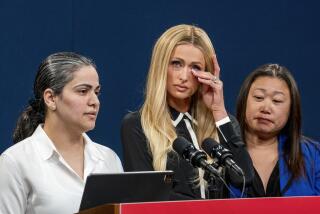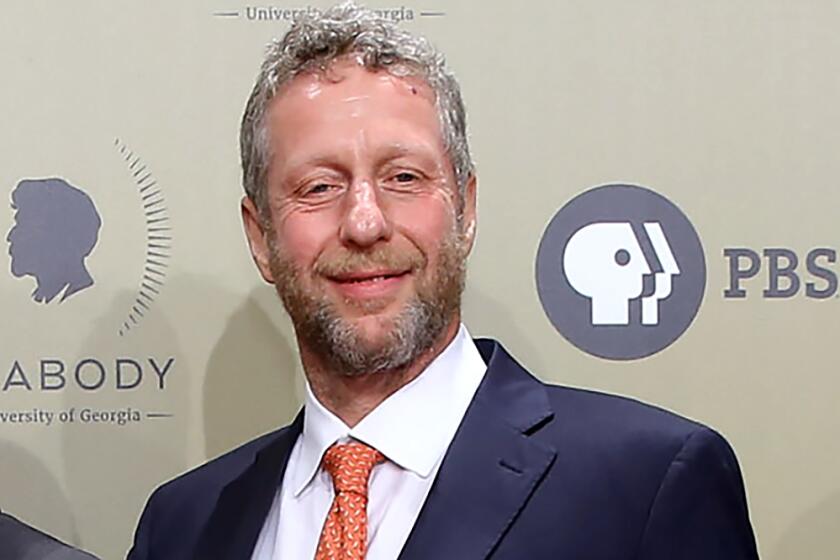AFL-CIO Split Puts Labor’s Path in Doubt
Two of the nation’s largest unions Monday officially bolted from the AFL-CIO, deepening a rift over the future of the struggling U.S. labor movement while raising questions about labor’s support of the Democratic Party.
The International Brotherhood of Teamsters and the Service Employees International Union, which together make up about one-fourth of the AFL-CIO’s 13 million members, said they were leaving the federation because of fundamental differences over organizing tactics and political activities.
The largest rift in organized labor in nearly 70 years was seen as a troubling, though expected, development by many in organized labor, and was blasted by AFL-CIO President John J. Sweeney as “a grievous insult.” The defections mean that the 50-year-old federation has lost two of its largest groups, which contribute about one-sixth of its total annual budget.
Two other prominent unions also are considering leaving the federation. Combined with the Teamsters and SEIU, their departure would result in the loss of nearly a third of the AFL-CIO’s members.
The federation, the dissenting unions said, spends too much time and money on political activities, and not enough on getting workers to join unions. The service employees union has pointed to its successes in courting and organizing low-wage immigrant workers, who are a major segment of the workforce in California.
Without the formal affiliation of the SEIU, the AFL-CIO’s politically influential Los Angeles County Federation of Labor stands to lose its largest faction -- which represents more than a third of the county’s union members.
Local union leaders expressed confidence that, regardless of the direction taken by national leaders, organized labor would remain strong and united in Los Angeles. Part of that unity is driven by a ballot fight looming this fall against several initiatives backed by Gov. Arnold Schwarzenegger that unions see as anti-labor.
“I would compare this to the first game of the World Series. There’s still a lot of game left to play,” said Martin Ludlow, the newly elected head of the Los Angeles County federation, which has been instrumental in electing numerous local politicians to office.
In recent weeks, the Teamsters, SEIU and five other unions have joined forces in the Change to Win coalition, which officials said was aimed at restoring power to the labor movement.
The SEIU has 1.8 million members and the Teamsters have 1.3 million, making them two of the three largest unions in the AFL-CIO. Teamsters President James P. Hoffa and SEIU President Andrew L. Stern said their unions planned to set aside an estimated $10 million to help the coalition recruit new union members.
“This was not done lightly,” Hoffa said at a news conference. “We must have more union members in order to change the political climate that is undermining workers’ rights in this country. The AFL-CIO has chosen the opposite approach.”
The news came on the first day of the federation’s annual labor convention here, where some of the American labor movement’s most epic battles have been fought.
In a town with the nation’s greatest number of Local 1s, and where the battle to establish an eight-hour workday led to bloodshed, Chicago seemed like a perfect place to celebrate the 50th anniversary of the merger between the American Federation of Labor (which mostly represented craft workers) and the Congress of Industrial Organizations (which mostly represented industrial and factory workers).
But most of the buzz leading up to the convention has revolved around the growing frustration over slumping membership.
Unions now represent about 12% of all workers, and less than 8% of those in the private sector. Fifty years ago, organized labor made up more than one-third of the workforce.
Although many convention attendees bemoaned the split, the rift had been building for months. On Sunday evening, leaders of the Teamsters, the service employees union, United Food and Commercial Workers and Unite Here, a garment and hotel workers union, announced that they would boycott the convention.
They said the decision came after recent talks to prevent the walkout failed. The boycott heightened expectations that some of the unions planned to cut ties with the federation this week.
Officials with the food and commercial workers union and Unite Here on Monday declined to comment on whether they also would leave the AFL-CIO. But the SEIU’s Stern said that as other coalition members talk about their options of staying or leaving, “everybody is on the same course as we are.”
Gerald McEntee, president of the American Federation of State, County and Municipal Employees, said union leaders had spent recent days cajoling the dissenting union members to stay with the AFL-CIO.
“This is a disgrace,” McEntee said. “We should be doing this together.”
Sweeney, the AFL-CIO president who is expected to be reelected to a third term this week, lambasted the defection in his Monday keynote address.
“At a time when our corporate and conservative adversaries have created the most powerful anti-worker political machine in the history of our country, a divided movement hurts the hopes of working families for a better life,” he said.
On Monday, numerous labor experts, union leaders and Democratic politicians said the spin-off could undercut unions’ bargaining power and undermine their political sway.
Although unions’ financial support is important for Democrats, labor’s ability to tell its workers why they should support the party is far more vital, particularly in close races, said Steve Elmendorf, a political strategist and deputy campaign manager for Sen. John F. Kerry of Massachusetts, last year’s Democratic presidential candidate.
“If we have a divided labor movement in 2008, if they are distracted or divided, that’s not going to be helpful to us,” Elmendorf said. “This is bad for Democrats, and good for Republicans.”
Union organizing has fallen dramatically in recent years: In 1998, the AFL-CIO organized 3,229 elections at companies to try to gain new union members, according to data from the U.S. Bureau of National Affairs. By 2004, that number had dropped about 28%.
At the same time, unions have increased their spending and support on both local and federal political races.
During the closely contested 2004 presidential race, unions sent thousands of organizers to key battleground states such as Ohio and West Virginia, and donated millions of dollars to support Kerry. The federation even lent some of its staff and organizers to help get out the vote, said Mike Asensio, a labor and employment attorney.
“That strategy clearly failed,” Asensio said. “They didn’t get the White House, they didn’t get Congress. That more than anything, led people like [SEIU President] Andy Stern to say, ‘Why on earth are we doing this?’ ”
At the convention Monday, several prominent Democratic lawmakers presented speeches but carefully avoided taking sides. They instead pleaded with the unions to work together.
Sen. Richard J. Durbin (D-Ill.) told attendees that corporations might see the split as a vulnerability.
“We have news for them. It’s not going to happen,” he said to a crowded auditorium. “Our unity is our strength. We will stand together and fight for working families.”
One of the concerns is whether the two sides will be competing against each other for members and membership dues, said Peter Morici, a business professor at the University of Maryland. “They are arguing over process, not product, and it’s the product that is the problem,” he said.
Although the split could be “quite harmful” to labor’s short-term ability to organize, it could eventually lead to a new era for the movement, said Ken Jacobs, deputy chair of UC Berkeley’s Center for Labor Research and Education.
“The fact that the wake-up call has happened, the fact that people are taking these problems seriously and grappling for an answer, is a good thing,” he said.
The SEIU’s Stern insisted that the dissenting unions weren’t trying to divide the labor movement, noting that “just because we want to take a different approach doesn’t mean we can’t all cooperate.”
The SEIU and Unite Here have been in the forefront of recognizing the need to organize low-paid immigrant workers in sectors such as hospitals, nursing homes, building security, commercial laundries and tourism -- all areas that are likely to expand in the service economy.
In California, such tactics seem to be working.
The individual unions’ innovative campaigns have brought tens of thousands of new members under the union umbrella in the last decade in California, and raised pay and benefits for most, even as wages have stagnated nationally and organized labor’s overall share of the workforce has declined.
But the defection will be felt deeply in the finances of the California Labor Federation, which also is affiliated with the AFL-CIO. Dues paid by service employees union members and the Teamsters make up almost one-third of its annual $4-million budget.
Art Pulaski, the federation’s executive secretary-treasurer, said labor officials had been holding off discussions of how to make up the financial gap until the split was official.
Now, among other things, the group will be more aggressive in collecting unpaid dues and try to woo other unions to help make up for the loss.
“We’re going to need to get the unions to circle the wagons and come together,” Pulaski said. “So far, in the conversations I’ve had, it seems like the unions are willing to do this.”
*
Times staff writers Noam N. Levey and Nancy Cleeland in Los Angeles contributed to this report. Huffstutter reported from Chicago, Vrana from Los Angeles.
More to Read
Get the L.A. Times Politics newsletter
Deeply reported insights into legislation, politics and policy from Sacramento, Washington and beyond. In your inbox three times per week.
You may occasionally receive promotional content from the Los Angeles Times.






